Project Report: Investment Analysis of the Australian Banking Sector
VerifiedAdded on 2020/02/18
|20
|4221
|426
Project
AI Summary
This project report delves into the realm of fundamental analysis, employing top-down and bottom-up approaches to evaluate the Australian banking industry, with a specific focus on ANZ Bank Australia and Commonwealth Bank of Australia. The report begins with an introduction to fundamental analysis, highlighting its significance in determining a security's intrinsic value through the examination of economic, qualitative, financial, and quantitative factors. The project then provides an overview of the chosen companies, followed by a detailed exploration of top-down analysis, encompassing industry changes, economic conditions, political factors, GDP, inflation rates, and fiscal policies. The report further presents an in-depth bottom-up analysis, using ratio analysis and financial data analysis to assess the financial health and performance of ANZ and Commonwealth Banks. The project includes the calculation and interpretation of various financial ratios, such as liquidity, profitability, and debt-equity ratios, to assess the companies' performance. The analysis also incorporates future projections and the impact of various economic indicators on the banking industry. Finally, the report concludes with a summary of findings and investment recommendations.
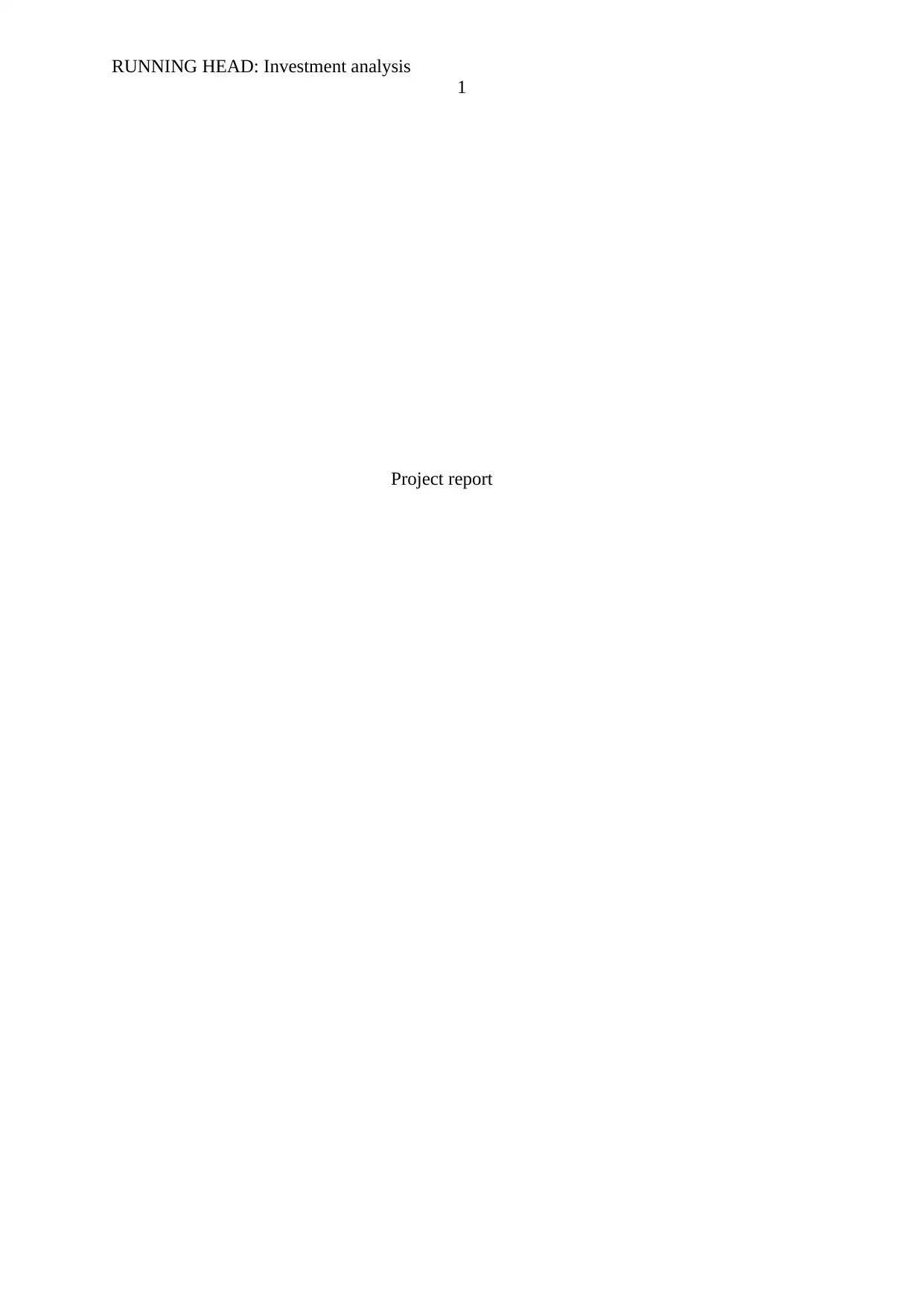
RUNNING HEAD: Investment analysis
1
Project report
1
Project report
Paraphrase This Document
Need a fresh take? Get an instant paraphrase of this document with our AI Paraphraser
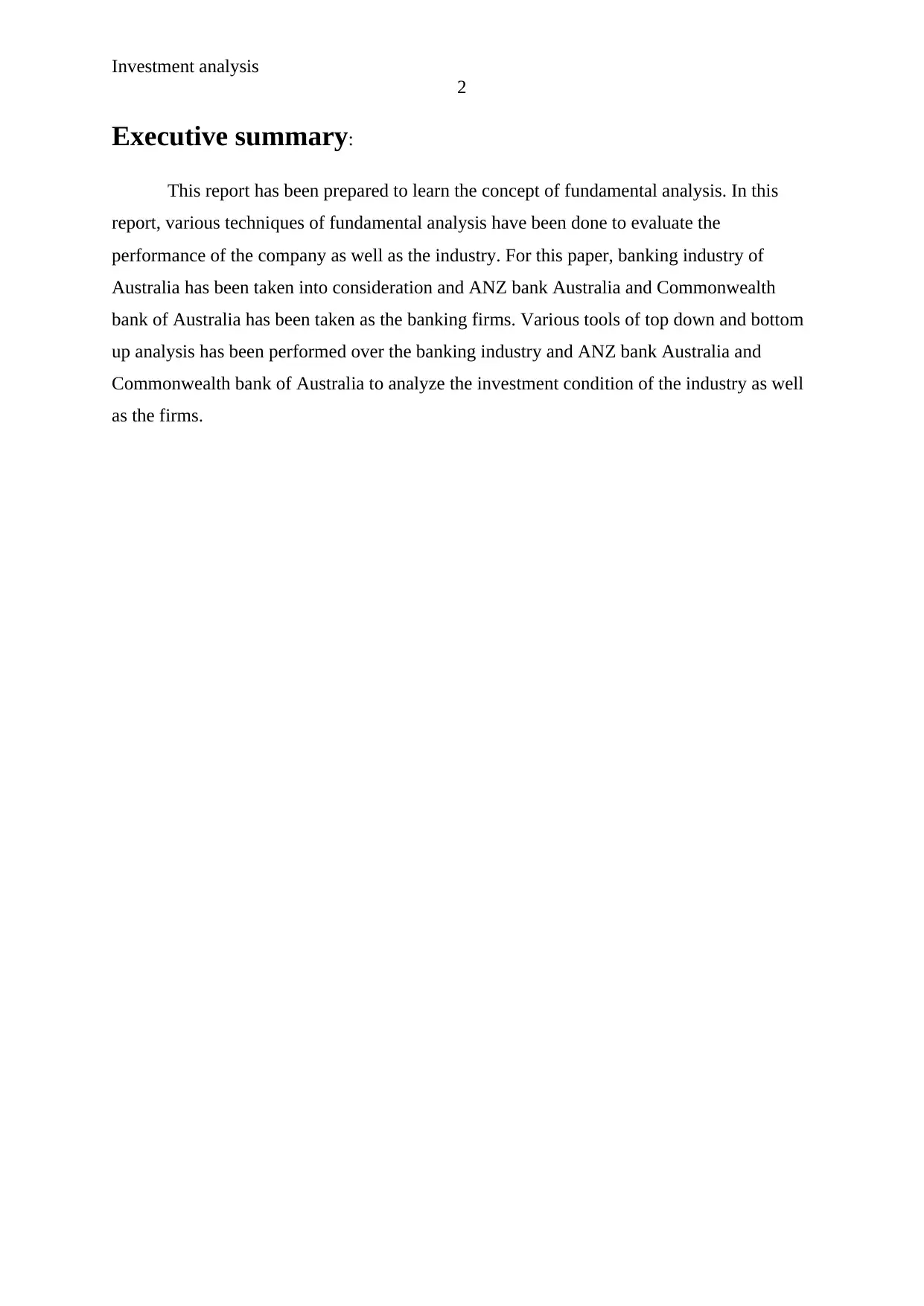
Investment analysis
2
Executive summary:
This report has been prepared to learn the concept of fundamental analysis. In this
report, various techniques of fundamental analysis have been done to evaluate the
performance of the company as well as the industry. For this paper, banking industry of
Australia has been taken into consideration and ANZ bank Australia and Commonwealth
bank of Australia has been taken as the banking firms. Various tools of top down and bottom
up analysis has been performed over the banking industry and ANZ bank Australia and
Commonwealth bank of Australia to analyze the investment condition of the industry as well
as the firms.
2
Executive summary:
This report has been prepared to learn the concept of fundamental analysis. In this
report, various techniques of fundamental analysis have been done to evaluate the
performance of the company as well as the industry. For this paper, banking industry of
Australia has been taken into consideration and ANZ bank Australia and Commonwealth
bank of Australia has been taken as the banking firms. Various tools of top down and bottom
up analysis has been performed over the banking industry and ANZ bank Australia and
Commonwealth bank of Australia to analyze the investment condition of the industry as well
as the firms.
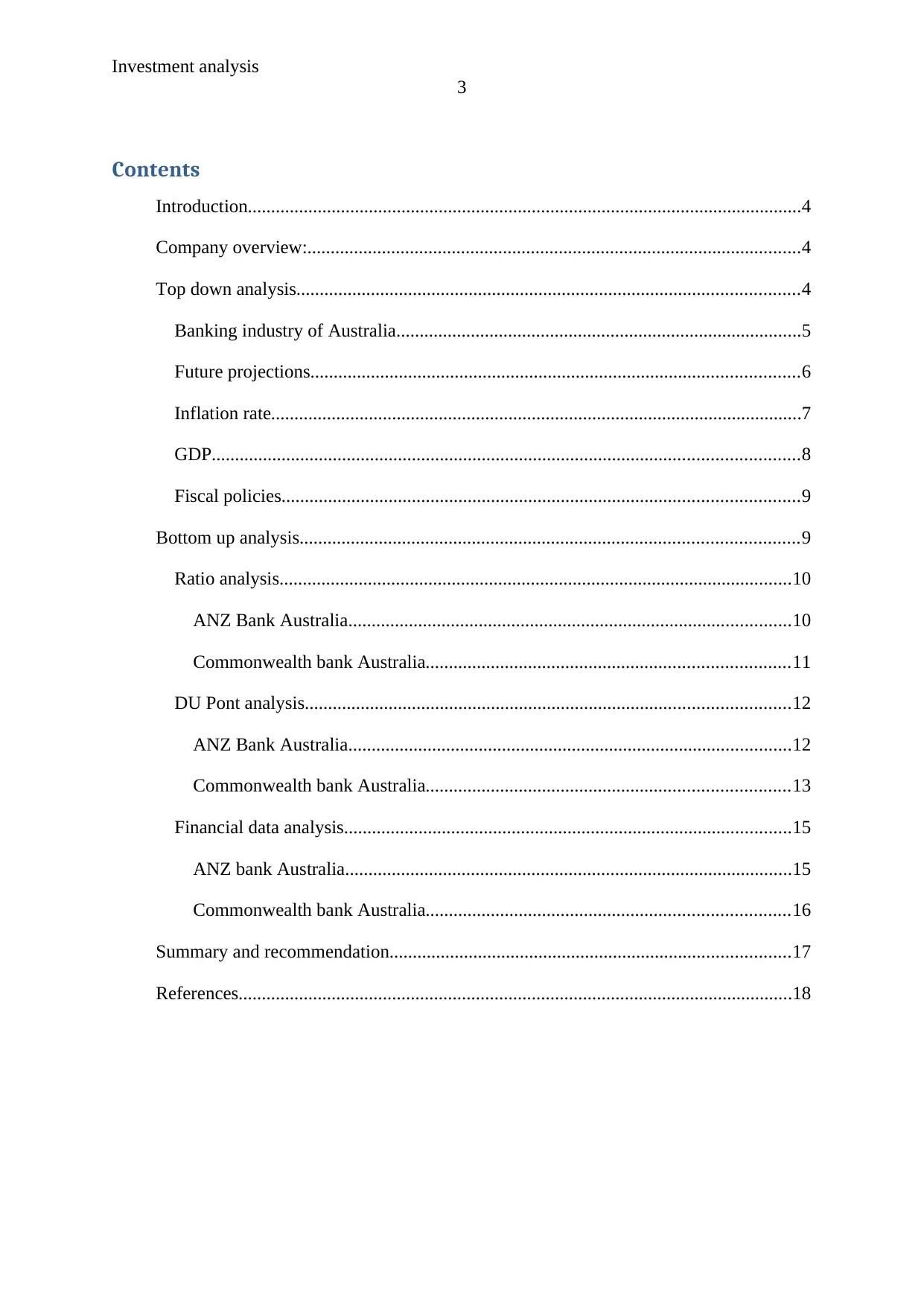
Investment analysis
3
Contents
Introduction.......................................................................................................................4
Company overview:..........................................................................................................4
Top down analysis............................................................................................................4
Banking industry of Australia.......................................................................................5
Future projections.........................................................................................................6
Inflation rate..................................................................................................................7
GDP..............................................................................................................................8
Fiscal policies...............................................................................................................9
Bottom up analysis...........................................................................................................9
Ratio analysis..............................................................................................................10
ANZ Bank Australia...............................................................................................10
Commonwealth bank Australia..............................................................................11
DU Pont analysis........................................................................................................12
ANZ Bank Australia...............................................................................................12
Commonwealth bank Australia..............................................................................13
Financial data analysis................................................................................................15
ANZ bank Australia................................................................................................15
Commonwealth bank Australia..............................................................................16
Summary and recommendation......................................................................................17
References.......................................................................................................................18
3
Contents
Introduction.......................................................................................................................4
Company overview:..........................................................................................................4
Top down analysis............................................................................................................4
Banking industry of Australia.......................................................................................5
Future projections.........................................................................................................6
Inflation rate..................................................................................................................7
GDP..............................................................................................................................8
Fiscal policies...............................................................................................................9
Bottom up analysis...........................................................................................................9
Ratio analysis..............................................................................................................10
ANZ Bank Australia...............................................................................................10
Commonwealth bank Australia..............................................................................11
DU Pont analysis........................................................................................................12
ANZ Bank Australia...............................................................................................12
Commonwealth bank Australia..............................................................................13
Financial data analysis................................................................................................15
ANZ bank Australia................................................................................................15
Commonwealth bank Australia..............................................................................16
Summary and recommendation......................................................................................17
References.......................................................................................................................18
⊘ This is a preview!⊘
Do you want full access?
Subscribe today to unlock all pages.

Trusted by 1+ million students worldwide
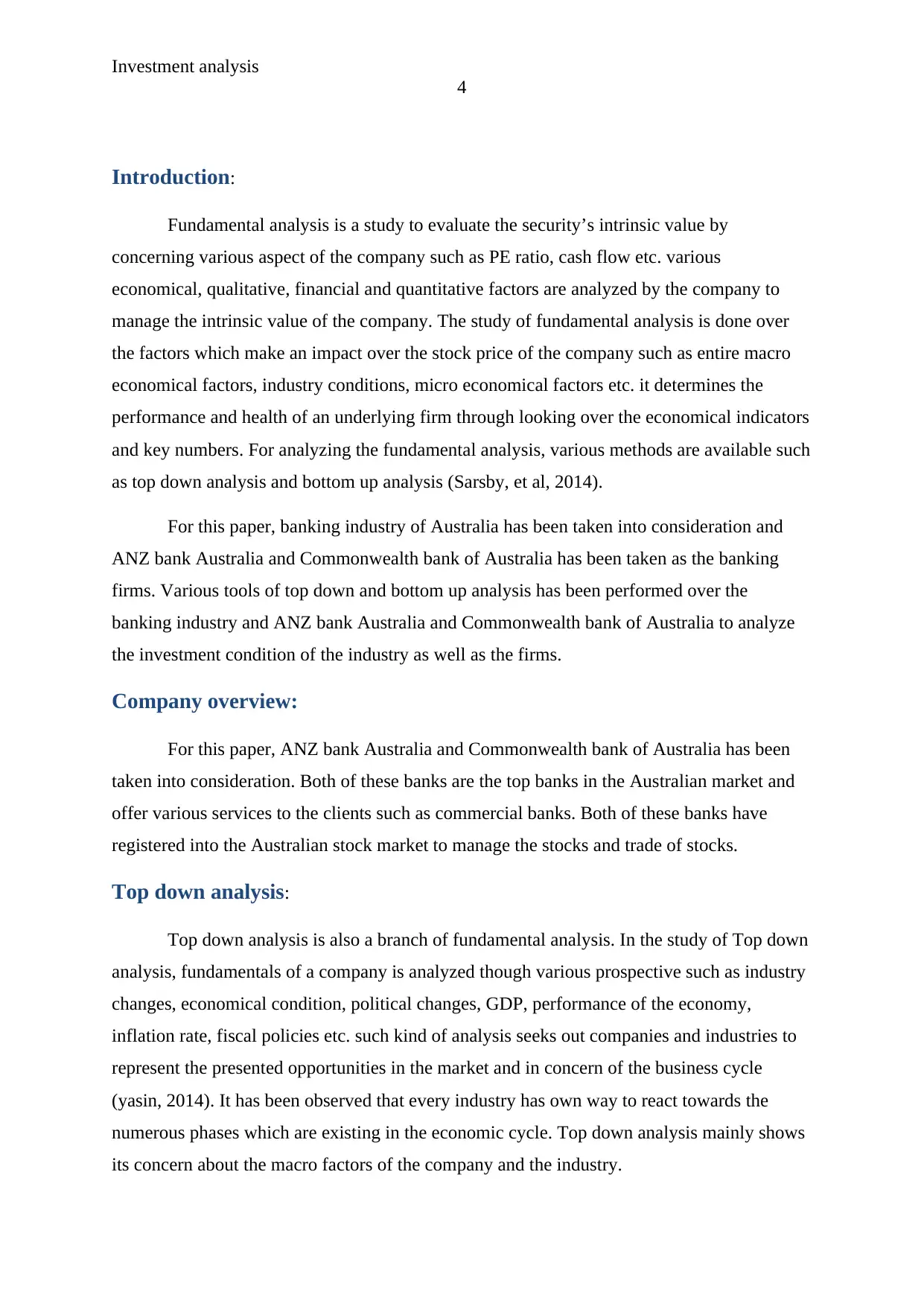
Investment analysis
4
Introduction:
Fundamental analysis is a study to evaluate the security’s intrinsic value by
concerning various aspect of the company such as PE ratio, cash flow etc. various
economical, qualitative, financial and quantitative factors are analyzed by the company to
manage the intrinsic value of the company. The study of fundamental analysis is done over
the factors which make an impact over the stock price of the company such as entire macro
economical factors, industry conditions, micro economical factors etc. it determines the
performance and health of an underlying firm through looking over the economical indicators
and key numbers. For analyzing the fundamental analysis, various methods are available such
as top down analysis and bottom up analysis (Sarsby, et al, 2014).
For this paper, banking industry of Australia has been taken into consideration and
ANZ bank Australia and Commonwealth bank of Australia has been taken as the banking
firms. Various tools of top down and bottom up analysis has been performed over the
banking industry and ANZ bank Australia and Commonwealth bank of Australia to analyze
the investment condition of the industry as well as the firms.
Company overview:
For this paper, ANZ bank Australia and Commonwealth bank of Australia has been
taken into consideration. Both of these banks are the top banks in the Australian market and
offer various services to the clients such as commercial banks. Both of these banks have
registered into the Australian stock market to manage the stocks and trade of stocks.
Top down analysis:
Top down analysis is also a branch of fundamental analysis. In the study of Top down
analysis, fundamentals of a company is analyzed though various prospective such as industry
changes, economical condition, political changes, GDP, performance of the economy,
inflation rate, fiscal policies etc. such kind of analysis seeks out companies and industries to
represent the presented opportunities in the market and in concern of the business cycle
(yasin, 2014). It has been observed that every industry has own way to react towards the
numerous phases which are existing in the economic cycle. Top down analysis mainly shows
its concern about the macro factors of the company and the industry.
4
Introduction:
Fundamental analysis is a study to evaluate the security’s intrinsic value by
concerning various aspect of the company such as PE ratio, cash flow etc. various
economical, qualitative, financial and quantitative factors are analyzed by the company to
manage the intrinsic value of the company. The study of fundamental analysis is done over
the factors which make an impact over the stock price of the company such as entire macro
economical factors, industry conditions, micro economical factors etc. it determines the
performance and health of an underlying firm through looking over the economical indicators
and key numbers. For analyzing the fundamental analysis, various methods are available such
as top down analysis and bottom up analysis (Sarsby, et al, 2014).
For this paper, banking industry of Australia has been taken into consideration and
ANZ bank Australia and Commonwealth bank of Australia has been taken as the banking
firms. Various tools of top down and bottom up analysis has been performed over the
banking industry and ANZ bank Australia and Commonwealth bank of Australia to analyze
the investment condition of the industry as well as the firms.
Company overview:
For this paper, ANZ bank Australia and Commonwealth bank of Australia has been
taken into consideration. Both of these banks are the top banks in the Australian market and
offer various services to the clients such as commercial banks. Both of these banks have
registered into the Australian stock market to manage the stocks and trade of stocks.
Top down analysis:
Top down analysis is also a branch of fundamental analysis. In the study of Top down
analysis, fundamentals of a company is analyzed though various prospective such as industry
changes, economical condition, political changes, GDP, performance of the economy,
inflation rate, fiscal policies etc. such kind of analysis seeks out companies and industries to
represent the presented opportunities in the market and in concern of the business cycle
(yasin, 2014). It has been observed that every industry has own way to react towards the
numerous phases which are existing in the economic cycle. Top down analysis mainly shows
its concern about the macro factors of the company and the industry.
Paraphrase This Document
Need a fresh take? Get an instant paraphrase of this document with our AI Paraphraser
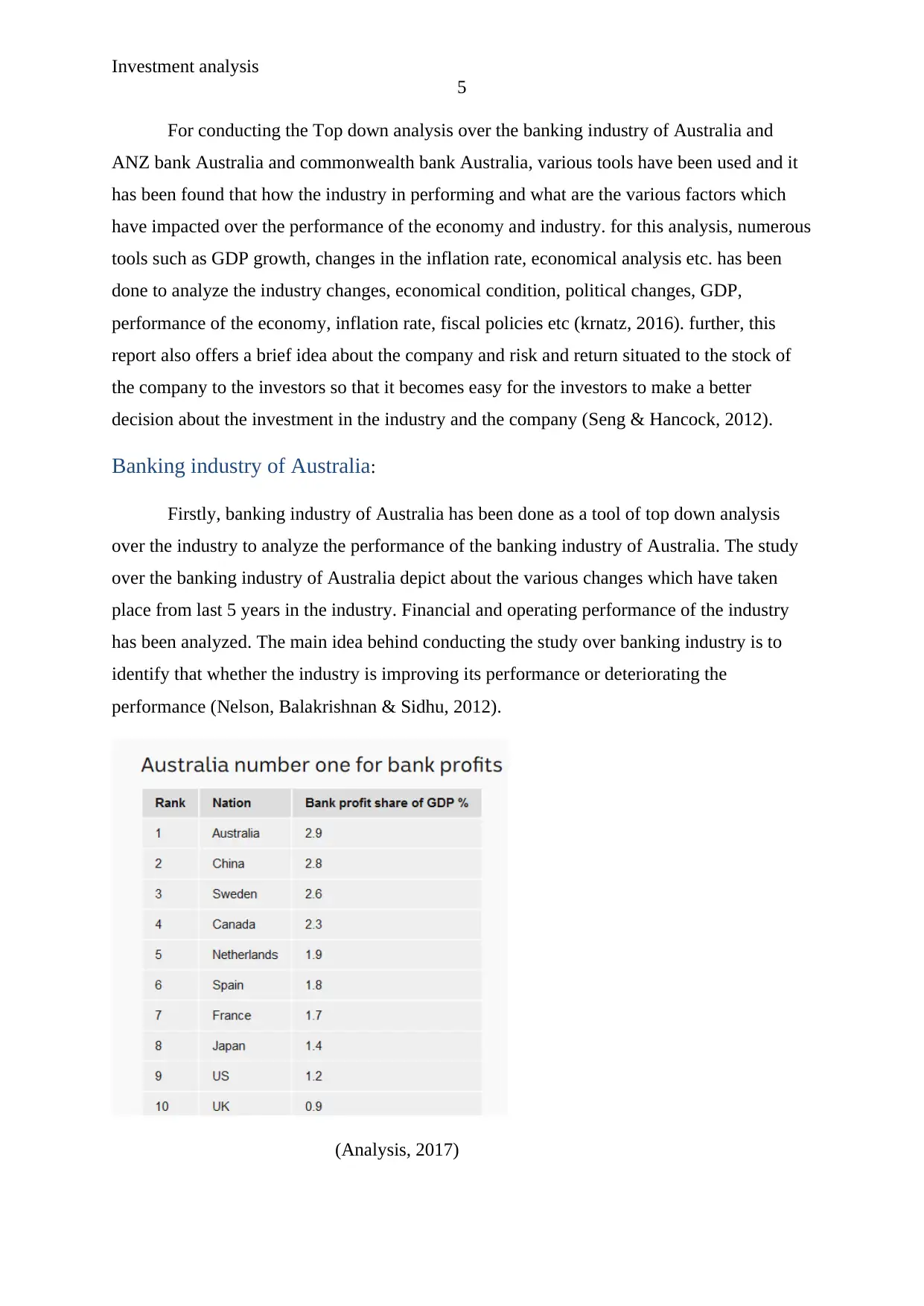
Investment analysis
5
For conducting the Top down analysis over the banking industry of Australia and
ANZ bank Australia and commonwealth bank Australia, various tools have been used and it
has been found that how the industry in performing and what are the various factors which
have impacted over the performance of the economy and industry. for this analysis, numerous
tools such as GDP growth, changes in the inflation rate, economical analysis etc. has been
done to analyze the industry changes, economical condition, political changes, GDP,
performance of the economy, inflation rate, fiscal policies etc (krnatz, 2016). further, this
report also offers a brief idea about the company and risk and return situated to the stock of
the company to the investors so that it becomes easy for the investors to make a better
decision about the investment in the industry and the company (Seng & Hancock, 2012).
Banking industry of Australia:
Firstly, banking industry of Australia has been done as a tool of top down analysis
over the industry to analyze the performance of the banking industry of Australia. The study
over the banking industry of Australia depict about the various changes which have taken
place from last 5 years in the industry. Financial and operating performance of the industry
has been analyzed. The main idea behind conducting the study over banking industry is to
identify that whether the industry is improving its performance or deteriorating the
performance (Nelson, Balakrishnan & Sidhu, 2012).
(Analysis, 2017)
5
For conducting the Top down analysis over the banking industry of Australia and
ANZ bank Australia and commonwealth bank Australia, various tools have been used and it
has been found that how the industry in performing and what are the various factors which
have impacted over the performance of the economy and industry. for this analysis, numerous
tools such as GDP growth, changes in the inflation rate, economical analysis etc. has been
done to analyze the industry changes, economical condition, political changes, GDP,
performance of the economy, inflation rate, fiscal policies etc (krnatz, 2016). further, this
report also offers a brief idea about the company and risk and return situated to the stock of
the company to the investors so that it becomes easy for the investors to make a better
decision about the investment in the industry and the company (Seng & Hancock, 2012).
Banking industry of Australia:
Firstly, banking industry of Australia has been done as a tool of top down analysis
over the industry to analyze the performance of the banking industry of Australia. The study
over the banking industry of Australia depict about the various changes which have taken
place from last 5 years in the industry. Financial and operating performance of the industry
has been analyzed. The main idea behind conducting the study over banking industry is to
identify that whether the industry is improving its performance or deteriorating the
performance (Nelson, Balakrishnan & Sidhu, 2012).
(Analysis, 2017)
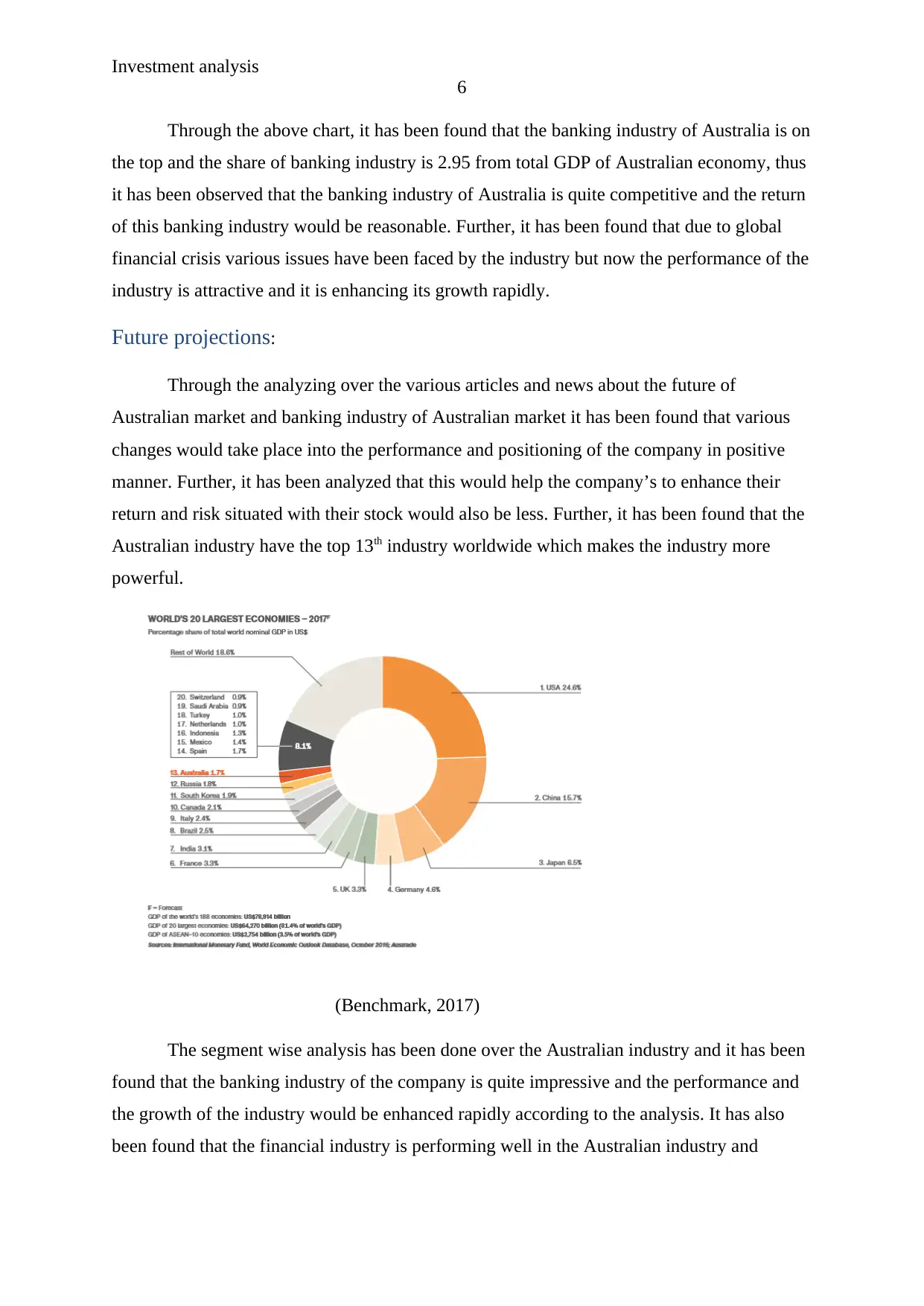
Investment analysis
6
Through the above chart, it has been found that the banking industry of Australia is on
the top and the share of banking industry is 2.95 from total GDP of Australian economy, thus
it has been observed that the banking industry of Australia is quite competitive and the return
of this banking industry would be reasonable. Further, it has been found that due to global
financial crisis various issues have been faced by the industry but now the performance of the
industry is attractive and it is enhancing its growth rapidly.
Future projections:
Through the analyzing over the various articles and news about the future of
Australian market and banking industry of Australian market it has been found that various
changes would take place into the performance and positioning of the company in positive
manner. Further, it has been analyzed that this would help the company’s to enhance their
return and risk situated with their stock would also be less. Further, it has been found that the
Australian industry have the top 13th industry worldwide which makes the industry more
powerful.
(Benchmark, 2017)
The segment wise analysis has been done over the Australian industry and it has been
found that the banking industry of the company is quite impressive and the performance and
the growth of the industry would be enhanced rapidly according to the analysis. It has also
been found that the financial industry is performing well in the Australian industry and
6
Through the above chart, it has been found that the banking industry of Australia is on
the top and the share of banking industry is 2.95 from total GDP of Australian economy, thus
it has been observed that the banking industry of Australia is quite competitive and the return
of this banking industry would be reasonable. Further, it has been found that due to global
financial crisis various issues have been faced by the industry but now the performance of the
industry is attractive and it is enhancing its growth rapidly.
Future projections:
Through the analyzing over the various articles and news about the future of
Australian market and banking industry of Australian market it has been found that various
changes would take place into the performance and positioning of the company in positive
manner. Further, it has been analyzed that this would help the company’s to enhance their
return and risk situated with their stock would also be less. Further, it has been found that the
Australian industry have the top 13th industry worldwide which makes the industry more
powerful.
(Benchmark, 2017)
The segment wise analysis has been done over the Australian industry and it has been
found that the banking industry of the company is quite impressive and the performance and
the growth of the industry would be enhanced rapidly according to the analysis. It has also
been found that the financial industry is performing well in the Australian industry and
⊘ This is a preview!⊘
Do you want full access?
Subscribe today to unlock all pages.

Trusted by 1+ million students worldwide
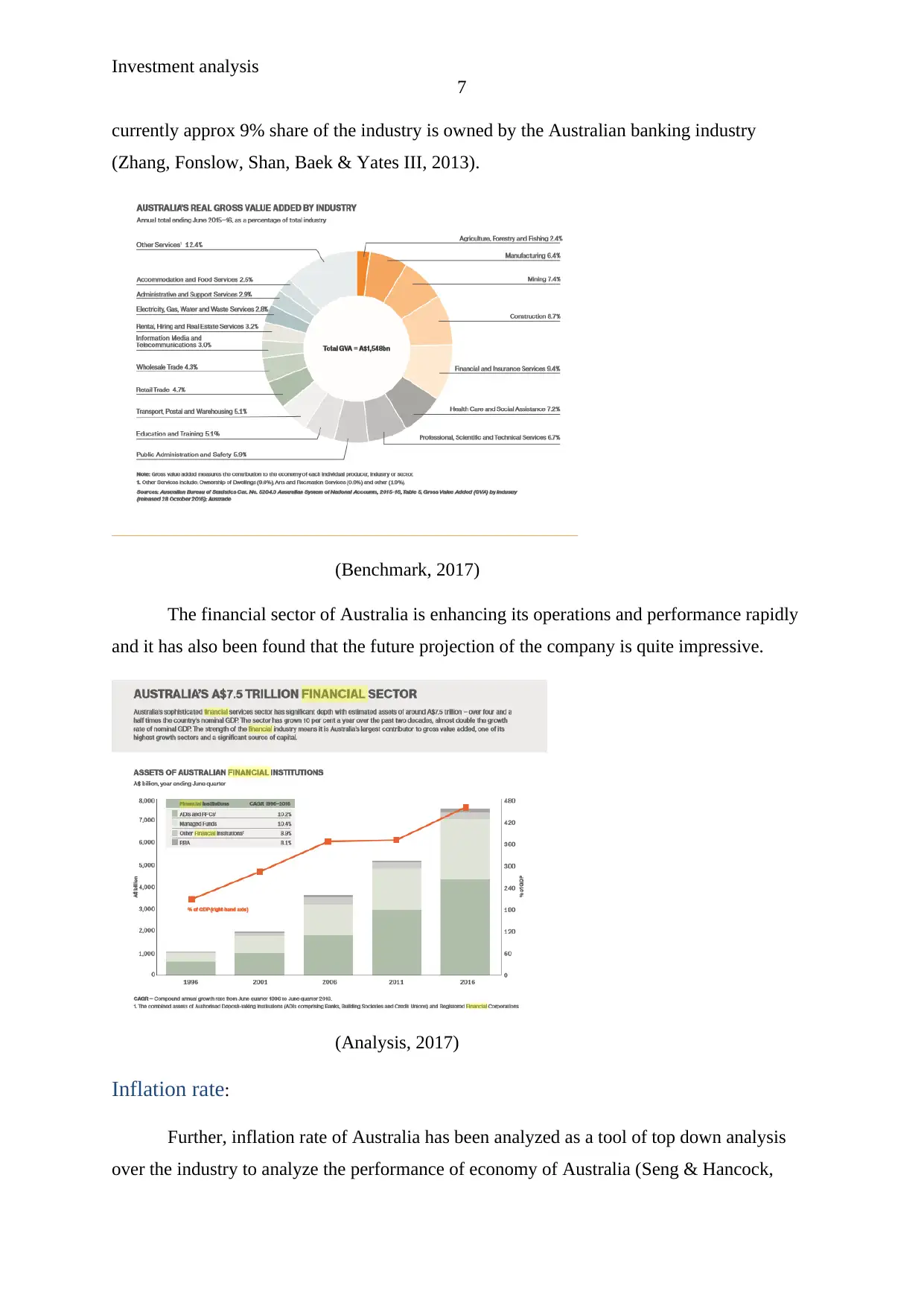
Investment analysis
7
currently approx 9% share of the industry is owned by the Australian banking industry
(Zhang, Fonslow, Shan, Baek & Yates III, 2013).
(Benchmark, 2017)
The financial sector of Australia is enhancing its operations and performance rapidly
and it has also been found that the future projection of the company is quite impressive.
(Analysis, 2017)
Inflation rate:
Further, inflation rate of Australia has been analyzed as a tool of top down analysis
over the industry to analyze the performance of economy of Australia (Seng & Hancock,
7
currently approx 9% share of the industry is owned by the Australian banking industry
(Zhang, Fonslow, Shan, Baek & Yates III, 2013).
(Benchmark, 2017)
The financial sector of Australia is enhancing its operations and performance rapidly
and it has also been found that the future projection of the company is quite impressive.
(Analysis, 2017)
Inflation rate:
Further, inflation rate of Australia has been analyzed as a tool of top down analysis
over the industry to analyze the performance of economy of Australia (Seng & Hancock,
Paraphrase This Document
Need a fresh take? Get an instant paraphrase of this document with our AI Paraphraser
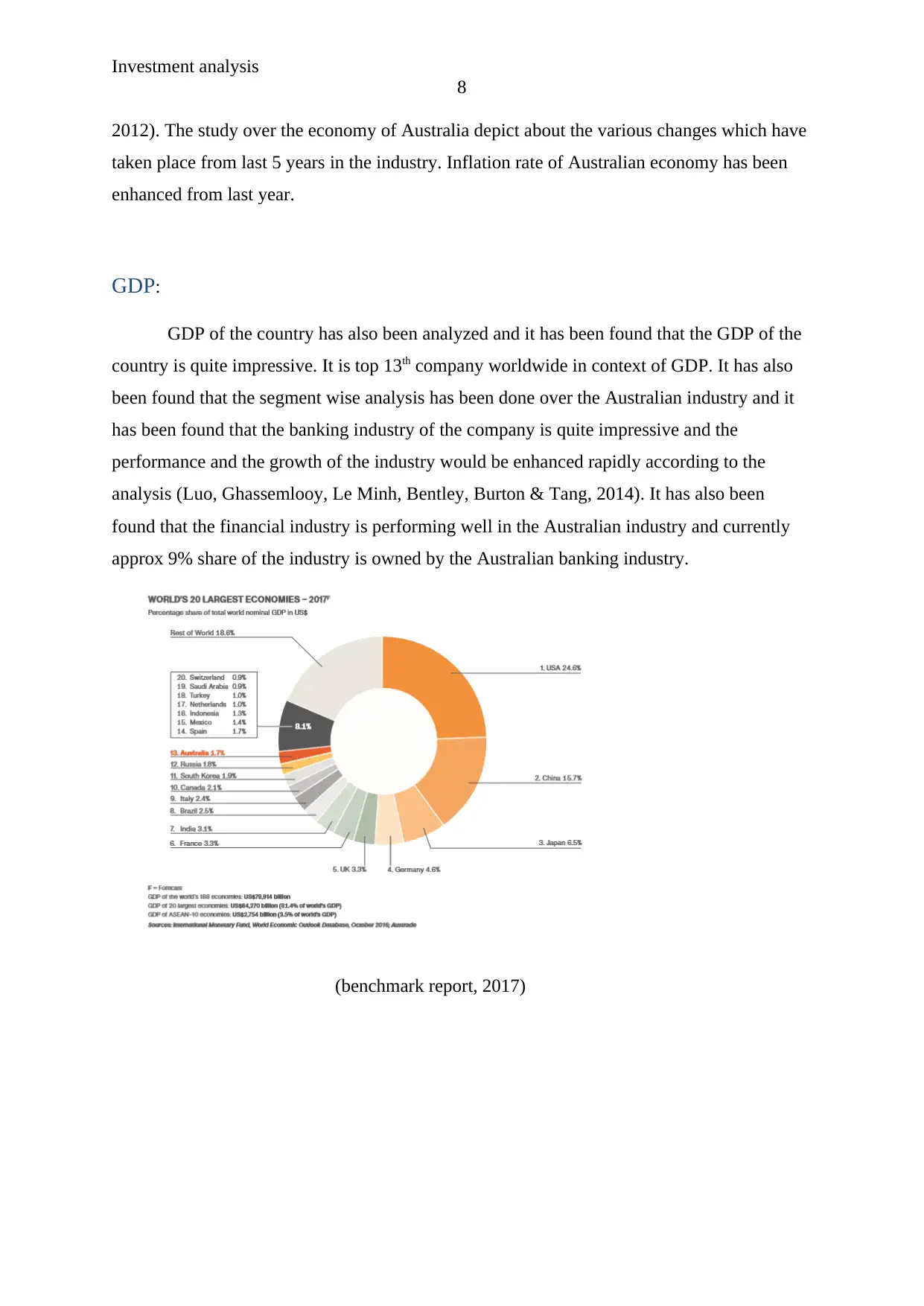
Investment analysis
8
2012). The study over the economy of Australia depict about the various changes which have
taken place from last 5 years in the industry. Inflation rate of Australian economy has been
enhanced from last year.
GDP:
GDP of the country has also been analyzed and it has been found that the GDP of the
country is quite impressive. It is top 13th company worldwide in context of GDP. It has also
been found that the segment wise analysis has been done over the Australian industry and it
has been found that the banking industry of the company is quite impressive and the
performance and the growth of the industry would be enhanced rapidly according to the
analysis (Luo, Ghassemlooy, Le Minh, Bentley, Burton & Tang, 2014). It has also been
found that the financial industry is performing well in the Australian industry and currently
approx 9% share of the industry is owned by the Australian banking industry.
(benchmark report, 2017)
8
2012). The study over the economy of Australia depict about the various changes which have
taken place from last 5 years in the industry. Inflation rate of Australian economy has been
enhanced from last year.
GDP:
GDP of the country has also been analyzed and it has been found that the GDP of the
country is quite impressive. It is top 13th company worldwide in context of GDP. It has also
been found that the segment wise analysis has been done over the Australian industry and it
has been found that the banking industry of the company is quite impressive and the
performance and the growth of the industry would be enhanced rapidly according to the
analysis (Luo, Ghassemlooy, Le Minh, Bentley, Burton & Tang, 2014). It has also been
found that the financial industry is performing well in the Australian industry and currently
approx 9% share of the industry is owned by the Australian banking industry.
(benchmark report, 2017)
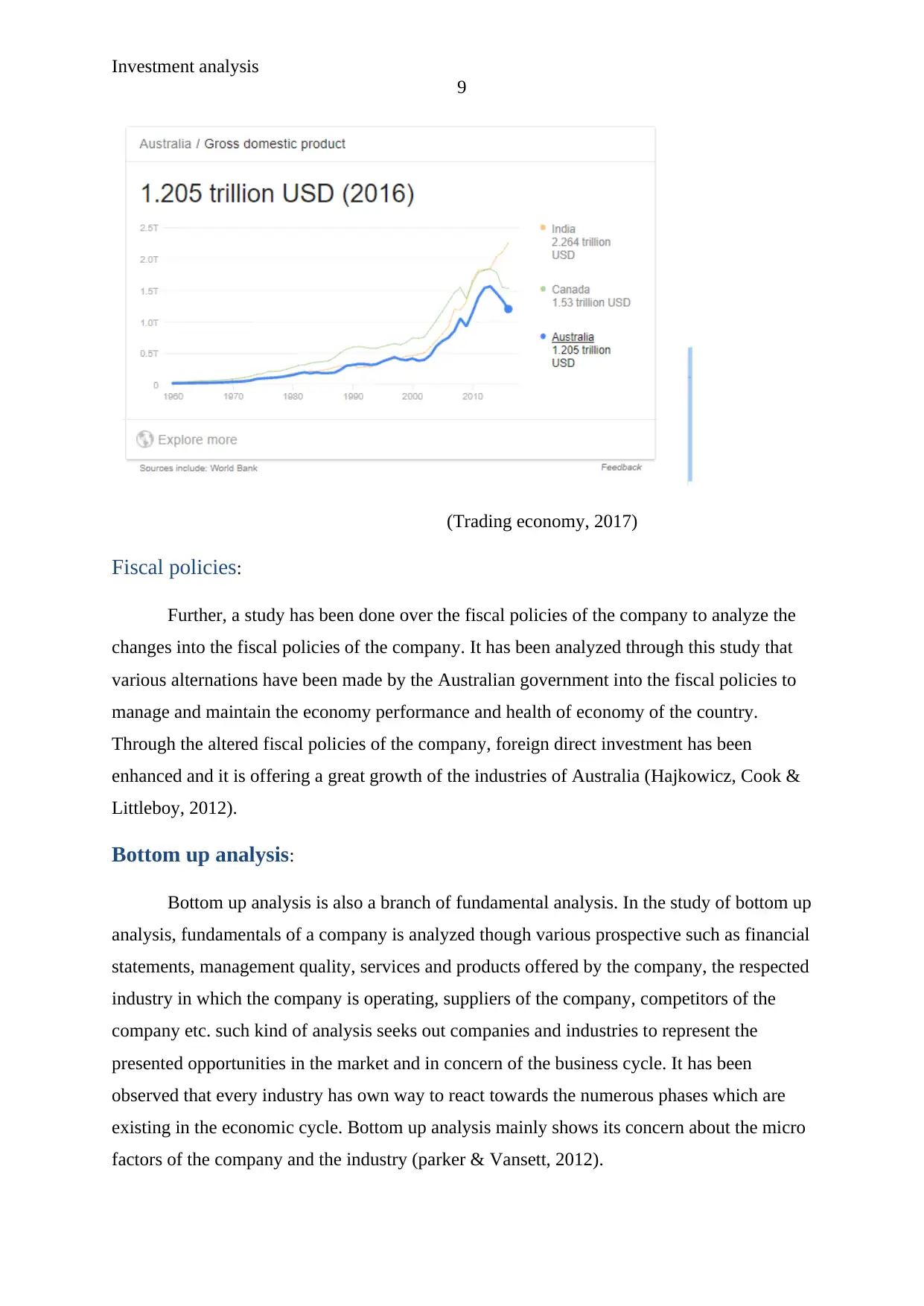
Investment analysis
9
(Trading economy, 2017)
Fiscal policies:
Further, a study has been done over the fiscal policies of the company to analyze the
changes into the fiscal policies of the company. It has been analyzed through this study that
various alternations have been made by the Australian government into the fiscal policies to
manage and maintain the economy performance and health of economy of the country.
Through the altered fiscal policies of the company, foreign direct investment has been
enhanced and it is offering a great growth of the industries of Australia (Hajkowicz, Cook &
Littleboy, 2012).
Bottom up analysis:
Bottom up analysis is also a branch of fundamental analysis. In the study of bottom up
analysis, fundamentals of a company is analyzed though various prospective such as financial
statements, management quality, services and products offered by the company, the respected
industry in which the company is operating, suppliers of the company, competitors of the
company etc. such kind of analysis seeks out companies and industries to represent the
presented opportunities in the market and in concern of the business cycle. It has been
observed that every industry has own way to react towards the numerous phases which are
existing in the economic cycle. Bottom up analysis mainly shows its concern about the micro
factors of the company and the industry (parker & Vansett, 2012).
9
(Trading economy, 2017)
Fiscal policies:
Further, a study has been done over the fiscal policies of the company to analyze the
changes into the fiscal policies of the company. It has been analyzed through this study that
various alternations have been made by the Australian government into the fiscal policies to
manage and maintain the economy performance and health of economy of the country.
Through the altered fiscal policies of the company, foreign direct investment has been
enhanced and it is offering a great growth of the industries of Australia (Hajkowicz, Cook &
Littleboy, 2012).
Bottom up analysis:
Bottom up analysis is also a branch of fundamental analysis. In the study of bottom up
analysis, fundamentals of a company is analyzed though various prospective such as financial
statements, management quality, services and products offered by the company, the respected
industry in which the company is operating, suppliers of the company, competitors of the
company etc. such kind of analysis seeks out companies and industries to represent the
presented opportunities in the market and in concern of the business cycle. It has been
observed that every industry has own way to react towards the numerous phases which are
existing in the economic cycle. Bottom up analysis mainly shows its concern about the micro
factors of the company and the industry (parker & Vansett, 2012).
⊘ This is a preview!⊘
Do you want full access?
Subscribe today to unlock all pages.

Trusted by 1+ million students worldwide
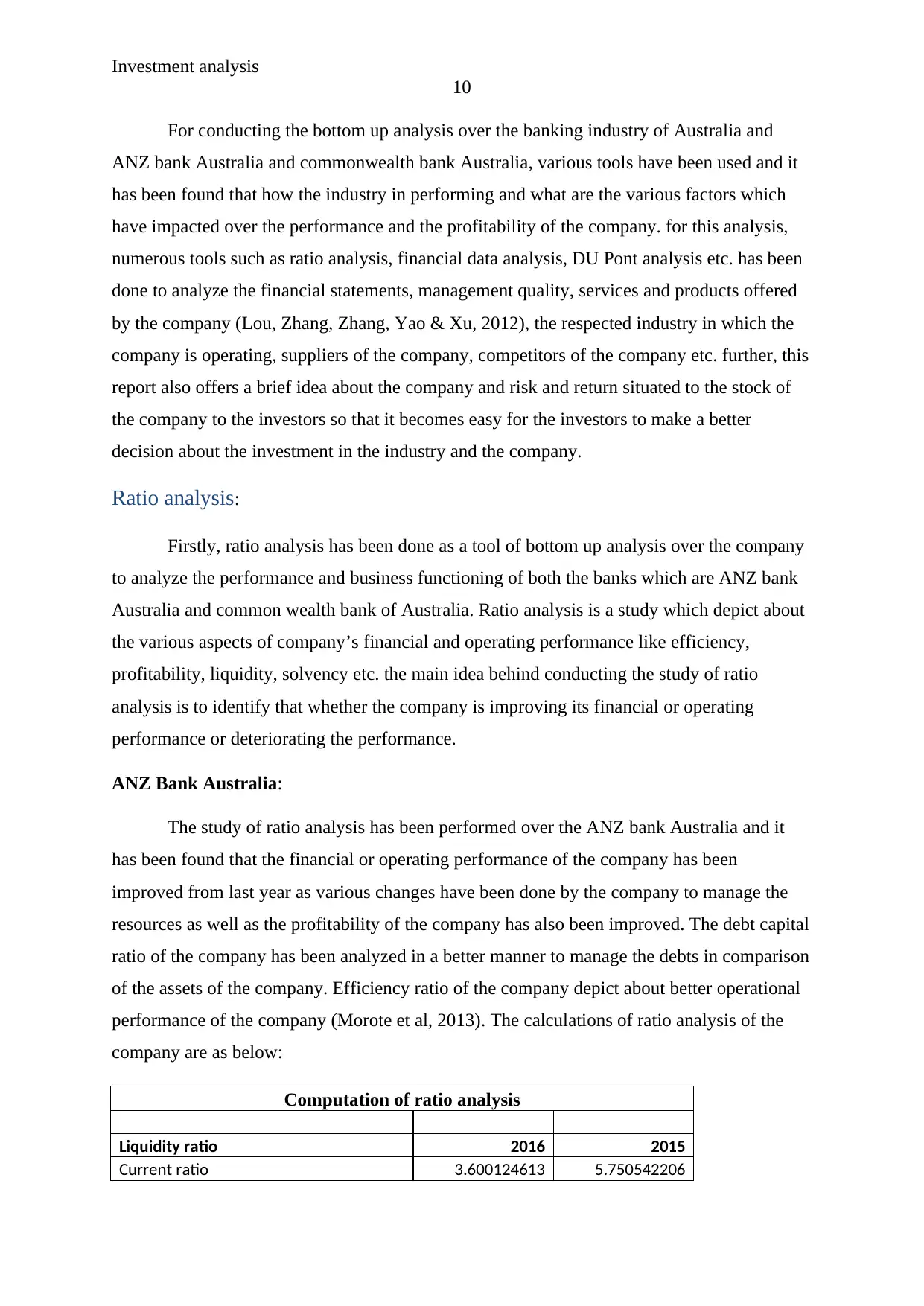
Investment analysis
10
For conducting the bottom up analysis over the banking industry of Australia and
ANZ bank Australia and commonwealth bank Australia, various tools have been used and it
has been found that how the industry in performing and what are the various factors which
have impacted over the performance and the profitability of the company. for this analysis,
numerous tools such as ratio analysis, financial data analysis, DU Pont analysis etc. has been
done to analyze the financial statements, management quality, services and products offered
by the company (Lou, Zhang, Zhang, Yao & Xu, 2012), the respected industry in which the
company is operating, suppliers of the company, competitors of the company etc. further, this
report also offers a brief idea about the company and risk and return situated to the stock of
the company to the investors so that it becomes easy for the investors to make a better
decision about the investment in the industry and the company.
Ratio analysis:
Firstly, ratio analysis has been done as a tool of bottom up analysis over the company
to analyze the performance and business functioning of both the banks which are ANZ bank
Australia and common wealth bank of Australia. Ratio analysis is a study which depict about
the various aspects of company’s financial and operating performance like efficiency,
profitability, liquidity, solvency etc. the main idea behind conducting the study of ratio
analysis is to identify that whether the company is improving its financial or operating
performance or deteriorating the performance.
ANZ Bank Australia:
The study of ratio analysis has been performed over the ANZ bank Australia and it
has been found that the financial or operating performance of the company has been
improved from last year as various changes have been done by the company to manage the
resources as well as the profitability of the company has also been improved. The debt capital
ratio of the company has been analyzed in a better manner to manage the debts in comparison
of the assets of the company. Efficiency ratio of the company depict about better operational
performance of the company (Morote et al, 2013). The calculations of ratio analysis of the
company are as below:
Computation of ratio analysis
Liquidity ratio 2016 2015
Current ratio 3.600124613 5.750542206
10
For conducting the bottom up analysis over the banking industry of Australia and
ANZ bank Australia and commonwealth bank Australia, various tools have been used and it
has been found that how the industry in performing and what are the various factors which
have impacted over the performance and the profitability of the company. for this analysis,
numerous tools such as ratio analysis, financial data analysis, DU Pont analysis etc. has been
done to analyze the financial statements, management quality, services and products offered
by the company (Lou, Zhang, Zhang, Yao & Xu, 2012), the respected industry in which the
company is operating, suppliers of the company, competitors of the company etc. further, this
report also offers a brief idea about the company and risk and return situated to the stock of
the company to the investors so that it becomes easy for the investors to make a better
decision about the investment in the industry and the company.
Ratio analysis:
Firstly, ratio analysis has been done as a tool of bottom up analysis over the company
to analyze the performance and business functioning of both the banks which are ANZ bank
Australia and common wealth bank of Australia. Ratio analysis is a study which depict about
the various aspects of company’s financial and operating performance like efficiency,
profitability, liquidity, solvency etc. the main idea behind conducting the study of ratio
analysis is to identify that whether the company is improving its financial or operating
performance or deteriorating the performance.
ANZ Bank Australia:
The study of ratio analysis has been performed over the ANZ bank Australia and it
has been found that the financial or operating performance of the company has been
improved from last year as various changes have been done by the company to manage the
resources as well as the profitability of the company has also been improved. The debt capital
ratio of the company has been analyzed in a better manner to manage the debts in comparison
of the assets of the company. Efficiency ratio of the company depict about better operational
performance of the company (Morote et al, 2013). The calculations of ratio analysis of the
company are as below:
Computation of ratio analysis
Liquidity ratio 2016 2015
Current ratio 3.600124613 5.750542206
Paraphrase This Document
Need a fresh take? Get an instant paraphrase of this document with our AI Paraphraser
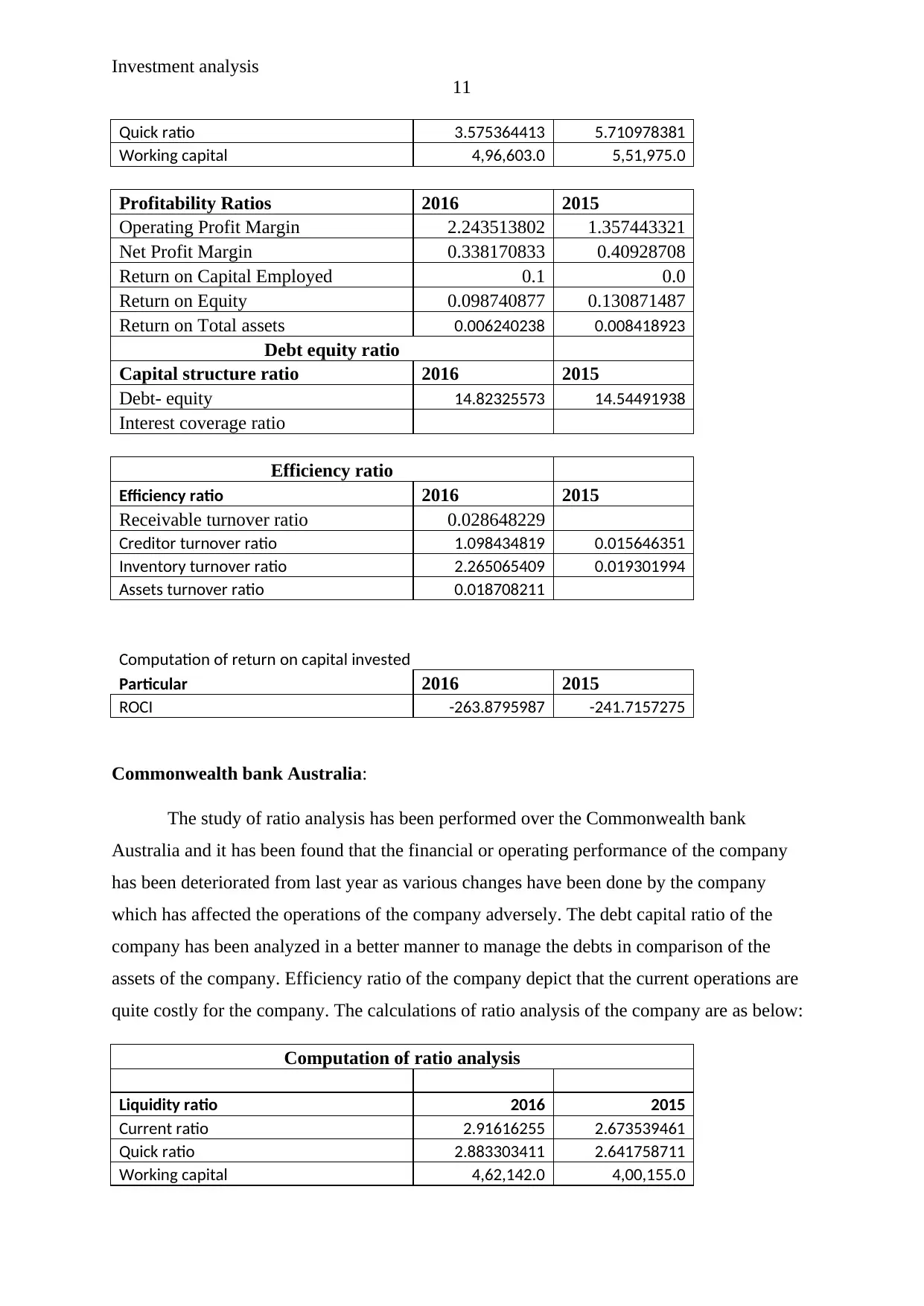
Investment analysis
11
Quick ratio 3.575364413 5.710978381
Working capital 4,96,603.0 5,51,975.0
Profitability Ratios 2016 2015
Operating Profit Margin 2.243513802 1.357443321
Net Profit Margin 0.338170833 0.40928708
Return on Capital Employed 0.1 0.0
Return on Equity 0.098740877 0.130871487
Return on Total assets 0.006240238 0.008418923
Debt equity ratio
Capital structure ratio 2016 2015
Debt- equity 14.82325573 14.54491938
Interest coverage ratio
Efficiency ratio
Efficiency ratio 2016 2015
Receivable turnover ratio 0.028648229
Creditor turnover ratio 1.098434819 0.015646351
Inventory turnover ratio 2.265065409 0.019301994
Assets turnover ratio 0.018708211
Computation of return on capital invested
Particular 2016 2015
ROCI -263.8795987 -241.7157275
Commonwealth bank Australia:
The study of ratio analysis has been performed over the Commonwealth bank
Australia and it has been found that the financial or operating performance of the company
has been deteriorated from last year as various changes have been done by the company
which has affected the operations of the company adversely. The debt capital ratio of the
company has been analyzed in a better manner to manage the debts in comparison of the
assets of the company. Efficiency ratio of the company depict that the current operations are
quite costly for the company. The calculations of ratio analysis of the company are as below:
Computation of ratio analysis
Liquidity ratio 2016 2015
Current ratio 2.91616255 2.673539461
Quick ratio 2.883303411 2.641758711
Working capital 4,62,142.0 4,00,155.0
11
Quick ratio 3.575364413 5.710978381
Working capital 4,96,603.0 5,51,975.0
Profitability Ratios 2016 2015
Operating Profit Margin 2.243513802 1.357443321
Net Profit Margin 0.338170833 0.40928708
Return on Capital Employed 0.1 0.0
Return on Equity 0.098740877 0.130871487
Return on Total assets 0.006240238 0.008418923
Debt equity ratio
Capital structure ratio 2016 2015
Debt- equity 14.82325573 14.54491938
Interest coverage ratio
Efficiency ratio
Efficiency ratio 2016 2015
Receivable turnover ratio 0.028648229
Creditor turnover ratio 1.098434819 0.015646351
Inventory turnover ratio 2.265065409 0.019301994
Assets turnover ratio 0.018708211
Computation of return on capital invested
Particular 2016 2015
ROCI -263.8795987 -241.7157275
Commonwealth bank Australia:
The study of ratio analysis has been performed over the Commonwealth bank
Australia and it has been found that the financial or operating performance of the company
has been deteriorated from last year as various changes have been done by the company
which has affected the operations of the company adversely. The debt capital ratio of the
company has been analyzed in a better manner to manage the debts in comparison of the
assets of the company. Efficiency ratio of the company depict that the current operations are
quite costly for the company. The calculations of ratio analysis of the company are as below:
Computation of ratio analysis
Liquidity ratio 2016 2015
Current ratio 2.91616255 2.673539461
Quick ratio 2.883303411 2.641758711
Working capital 4,62,142.0 4,00,155.0
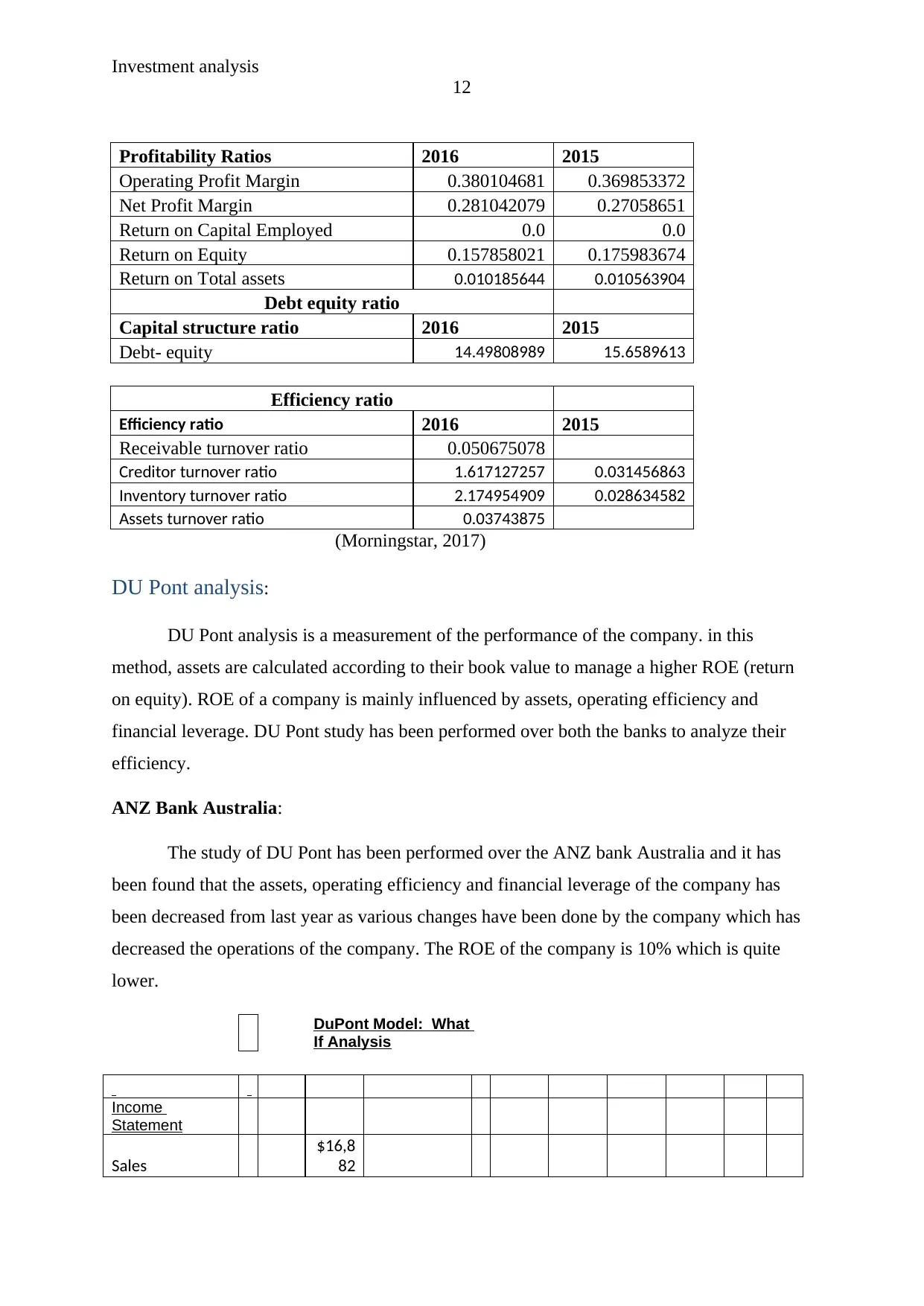
Investment analysis
12
Profitability Ratios 2016 2015
Operating Profit Margin 0.380104681 0.369853372
Net Profit Margin 0.281042079 0.27058651
Return on Capital Employed 0.0 0.0
Return on Equity 0.157858021 0.175983674
Return on Total assets 0.010185644 0.010563904
Debt equity ratio
Capital structure ratio 2016 2015
Debt- equity 14.49808989 15.6589613
Efficiency ratio
Efficiency ratio 2016 2015
Receivable turnover ratio 0.050675078
Creditor turnover ratio 1.617127257 0.031456863
Inventory turnover ratio 2.174954909 0.028634582
Assets turnover ratio 0.03743875
(Morningstar, 2017)
DU Pont analysis:
DU Pont analysis is a measurement of the performance of the company. in this
method, assets are calculated according to their book value to manage a higher ROE (return
on equity). ROE of a company is mainly influenced by assets, operating efficiency and
financial leverage. DU Pont study has been performed over both the banks to analyze their
efficiency.
ANZ Bank Australia:
The study of DU Pont has been performed over the ANZ bank Australia and it has
been found that the assets, operating efficiency and financial leverage of the company has
been decreased from last year as various changes have been done by the company which has
decreased the operations of the company. The ROE of the company is 10% which is quite
lower.
DuPont Model: What
If Analysis
Income
Statement
Sales
$16,8
82
12
Profitability Ratios 2016 2015
Operating Profit Margin 0.380104681 0.369853372
Net Profit Margin 0.281042079 0.27058651
Return on Capital Employed 0.0 0.0
Return on Equity 0.157858021 0.175983674
Return on Total assets 0.010185644 0.010563904
Debt equity ratio
Capital structure ratio 2016 2015
Debt- equity 14.49808989 15.6589613
Efficiency ratio
Efficiency ratio 2016 2015
Receivable turnover ratio 0.050675078
Creditor turnover ratio 1.617127257 0.031456863
Inventory turnover ratio 2.174954909 0.028634582
Assets turnover ratio 0.03743875
(Morningstar, 2017)
DU Pont analysis:
DU Pont analysis is a measurement of the performance of the company. in this
method, assets are calculated according to their book value to manage a higher ROE (return
on equity). ROE of a company is mainly influenced by assets, operating efficiency and
financial leverage. DU Pont study has been performed over both the banks to analyze their
efficiency.
ANZ Bank Australia:
The study of DU Pont has been performed over the ANZ bank Australia and it has
been found that the assets, operating efficiency and financial leverage of the company has
been decreased from last year as various changes have been done by the company which has
decreased the operations of the company. The ROE of the company is 10% which is quite
lower.
DuPont Model: What
If Analysis
Income
Statement
Sales
$16,8
82
⊘ This is a preview!⊘
Do you want full access?
Subscribe today to unlock all pages.

Trusted by 1+ million students worldwide
1 out of 20
Related Documents
Your All-in-One AI-Powered Toolkit for Academic Success.
+13062052269
info@desklib.com
Available 24*7 on WhatsApp / Email
![[object Object]](/_next/static/media/star-bottom.7253800d.svg)
Unlock your academic potential
Copyright © 2020–2025 A2Z Services. All Rights Reserved. Developed and managed by ZUCOL.





